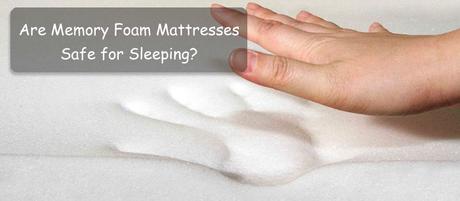Good question: are memory foam mattresses safe for sleeping on? Why should they not be? Why should it be possible to purchase a mattress that is unsafe to sleep on? Let's have a look at the safety of memory foam mattresses, and establish what the risks are in using them.

What Are Memory Foam Mattresses?
Memory foam mattresses are mattresses that use a certain type of heat and pressure-sensitive foam that conforms to your body shape when you lie on them. The foam softens with pressure and your body heat to provide you with the best possible support for those parts of your body that are in contact with your mattress.
If you suffer from certain conditions such as arthritis, backache or orthopedic issues with your spine that can affect your neck all the way down to your lumbar area, then this type of support when you are in bed will make you feel much more comfortable. Many people who suffer from sciatica find that memory foam mattresses help them to get to sleep faster and provide them with a better quality of sleep.
So what is this special foam that conforms to your body shape, and then reverts to that shape much quicker the next time you lay on your memory foam mattress? Before we discuss the safety of such mattresses lets first have a look at what type of foam we are talking about here.
What is Memory Foam
Memory foam is a type of polyurethane foam containing certain chemicals to increase the density of the foam, and to make it respond to pressure and temperature. It is technically known as viscoelastic foam, which softens as a reaction to your body- heat and can mould around your warm body very rapidly.
Once you are lying on it, it very quickly assumes your body shape and provides the maximum possible support to your pressure points: head, neck, shoulders, lower back, buttocks, hips, and knees to name just the more important of these. Neck support comes from the fact your head and shoulders sink into foam, which then supports your neck. If you suffer any orthopedic conditions that can lead to pain if your body is not properly supported, then this type of mattress is the ideal one for you. You will be able to sleep at night with the minimum of distress to your joints and muscles.
The Safety of Memory Foam Mattresses
Most people can use a memory foam mattress without any problems at all. So why do people ask the question: " Are memory foam mattresses safe for sleeping on?" Sure, there are certain issues with memory foam mattresses that some people have brought to light. However, these tend to be relatively few in proportion to the number who use them. Here are some of these because you should be made aware of them before you decide to buy this type of mattress.
There are two specific types of risk that people associate with memory foam mattresses. One is chemical and the other is physical. Let's look at the chemical risk first.
Chemical Issues with Memory Foam Mattresses:
The polyurethane used to manufacture memory foam mattresses contains certain chemicals that provide specific beneficial properties to the foam. These chemicals can vary according to the manufacturer concerned. Such substances not only enable a foam (or mattress) to support you when and where you need it, but also to revert back to its original form and shape once you rise from it. Nobody wants a mattress that conforms to their shape but does not go flat again when they leave it.
When you first receive delivery of a memory foam mattress, you may notice a chemical smell coming from it. That is the residue from the materials used to manufacture the foam and sometimes to fireproof it. Such volatile substances soon evaporate off and dissipate, after which your mattress should be odor free.
The most common chemical components of memory foam and of all polyurethanes, including polyurethane paints, are substances known as diisocyanates. In their raw states, diisocyanates can lead to respiratory issues and dermatitis, but when polymerized they are relatively harmless. These are not a significant chemical issue with polyurethane foams. The main issue is off-gassing.
Off-gassing is no more than the release of chemical fumes from the finished foam. Once any foam has been manufactured there are generally some solvent fumes still trapped in the foam's structure. This is released over time, and when you first unpack your mattress you may be able to smell it. This odor generally dissipates after a short period - normally within 2 days or so.
If you wait a day or two after removing all the packaging from your memory foam mattress, the smell will disappear and any issue you feel that is associated with these chemicals will have dissipated. Let's face it: if we delved into the chemical nature of all common household items you would hardly ever feel safe walking into your home! Memory foam mattresses are generally safe for sleeping on.
Are Memory Foam Mattresses Safe for Sleeping Children?
The physical issues associated with memory foam mattresses relate to the fact that your pressure points tend to sink into the mattress. This can present a hazard to very young children. You should never lie a child face down on such mattresses. If you do, the mattress may form an indentation or trough to accommodate the head. Because he or she is lying face down, your child's face may be trapped in that trough which will fill with carbon dioxide from the child's breath.
Very young children may not have the strength to turn their body around to get their face out of this trough - resulting in suffocation. Laying children face down in bed may be one reason for the unexpected death of infants known as SIDS (Sudden Infant Death Syndrome). For more information on SIDS and potential causes for it, including memory foam mattresses, check out the Summit Medical Group website. Very young children are not strong enough to lift their head from the depression made by memory foam.
Choosing the Safest Memory Foam Mattress
Don't get us wrong here! Memory foam mattresses are safe to sleep on. There are no doubts about that. However, it is best if you understand all the potential hazards. Other types of mattress have their own safety issues, and you have to balance the risks against the benefits. The benefits of memory foam mattresses are very significant to those with orthopedic issues, or who find it difficult to sleep at nights. They are extremely comfortable, and most that use memory foam mattresses will never change!
The chemical odor is no more than you get from any other type of new foam mattress - latex foams also emit an initial chemical smell as can foam toppers of innerspring mattresses. So that is not a significant issue, and certainly not one associated only with memory foams. Just don't use one for a baby or child under 6 months - or maybe one year old if you want to be absolutely sure. Check out the Summit Medical Group website above if you want more information.
Mattress Certification: Finally, if you need some official certification of the safety of memory foam mattresses, look for one of the standard certifications on the manufacturer's website. If the mattress is CertiPur-US Certified it is free from some of the more toxic chemicals that can be used in manufacture.
Safety of Memory Foam Mattresses: Conclusion
So, in conclusion, are memory foam mattresses safe for sleeping? The answer is yes, they are but take care with very young children. Memory foam mattresses are no more hazardous than any other mattress when use correctly, and memory foam offers no more chemical issues than latex foam. Years of successful and trouble-free use by people worldwide have proved that memory foam is just as safe to use as any other type of mattress - other than for infants unable to raise their heads and turn over in bed.

